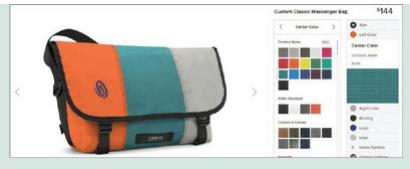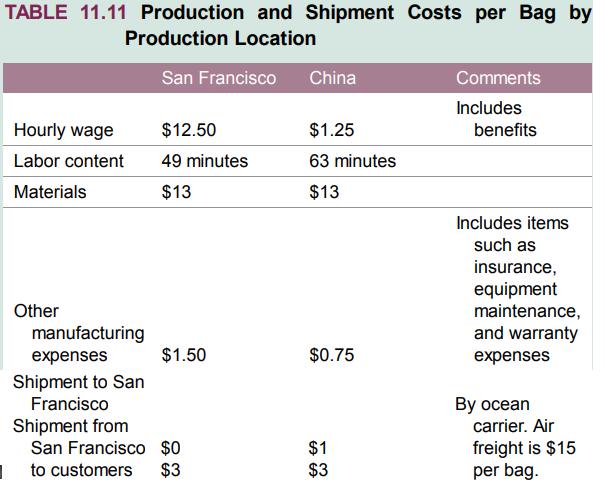1. What is the total cost of making a bag in San Francisco? What is the total...
Question:
1. What is the total cost of making a bag in San Francisco? What is the total cost of making a bag in China, including the transportation cost of shipping the bag from China to the United States?
2. Suppose Timbuk2 does move production of wholesale bags to China. Let’s say it can place orders with its Chinese supplier every four weeks; that is, one period equals four weeks. Its lead time is two periods; that is, L = 2. Average demand for one type of wholesale bag is 200 bags per period (i.e., they sell, on average, 200 bags every four weeks), with a standard deviation of 100 bags. The holding cost for each bag each period is $1, and it would operate with a 2.5 safety factor. How much inventory, on average, would it have on order and on hand? What would be the inventory holding cost per bag?
3. Should it move production of custom bags to China? Should it move production of wholesale bags to China?
Rob Honeycutt created Timbuk2 to offer consumers the ability to make their own custom, three-panel messenger bags. And instead of following the standard strategy of manufacturing in Asia, Rob set up Timbuk2 in San Francisco with its own facility. But is this the best strategy? Should Timbuk2 consider moving production to China?
The image above displays a screenshot from Timbuk2’s online retailing website that allows customers to customize their messenger bag to their own particular tastes. A customer can select one color for each of the three panels and a separate color, if they want, for the Timbuk2 “swirl” logo. The color options change over time, to keep things “fresh,” but at any one time Timbuk2 generally offers at least 16 options for each panel and the logo.
Once customized, Timbuk2 manufactures the bag in San Francisco and then ships the bag to the customer within two to three days.
Timbuk2 sells bags through its online store for about $100 per bag. Although it would love to sell bags only through its website and to sell many more of them, the market for custom bags at this price point is only so big. So Timbuk2 sells bags through other channels as well. For example, retailers such as REI purchase a limited selection of bags to sell in their stores. While Timbuk2 appreciates sales through this wholesale channel, they don’t generate the same revenue per bag as the online channel—more like $35 per bag. Even though the wholesale bags generally do not involve nearly the same level of customization as the online bags (i.e., retailers tend to select more conservative color combinations), those bags are made on the same production line as the online bags. However, the promised lead time to wholesale customers is longer, more like two to three weeks.

The decision as to whether to send production to China involves a number of issues. Table 11.11 provides a cost comparison between production in San Francisco and in China. There is clearly a dramatic difference in labor costs on a per-hour basis, but the workers in San Francisco are slightly more productive (they require 49 minutes per bag instead of 63 minutes). Material costs do not differ between the two options, because in both cases materials are procured in China. It costs $1 per bag to send it from China via ocean carrier, but the lead time is probably eight weeks when all of the steps are accounted for (e.g., production, movement to the port, and actual shipping). To get a faster lead time would require air shipments, but that is much more expensive: $15 per bag.

Of course, Table 11.11 doesn’t tell the entire story. There would be costs associated with finding a good supplier and monitoring that supplier. And it isn’t clear how Timbuk2’s customers would react to the move—from its start, Timbuk2 emphasized with pride that it was made in San Francisco. Does moving production to China eliminate part of the brand’s cache with customers?
Step by Step Answer:

Operations Management
ISBN: 9781260547610
2nd International Edition
Authors: Gerard Cachon, Christian Terwiesch





